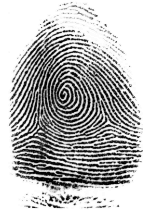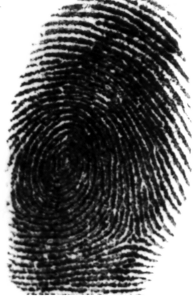Clarity Assessment
Example of Good Clarity.
Note the clearly-defined ridge pathways and the distinct shapes & orientation of the friction ridge features.
Example of Poor Clarity.
Note how the friction ridges have become diffuse. There is a lack of distinction between the edges of the ridges and the intervening valleys. The shapes of the incipient ridges have become imprecise.
Clarity of Friction Ridge Detail
The degree of Clarity exhibited by the latent print impression determines the level of tolerance that is acceptable to the examiner. The degree of clarity influences the quantity and level of friction ridge features required to Evaluate for an Exclusion or an Individualization.
A latent print impression exhibiting good Clarity will depict unambiguous morphology throughout its overall pattern area, and amongst its friction ridge formations. Well-defined individual ridge paths, distinct friction ridge edges and incipient ridges are also hallmarks of a latent print impression exhibiting good Clarity.
The greater the Clarity depicted by the latent print impression, the lower the level of tolerance that is permitted for differences in the appearance of the friction ridge formations between impressions. Thus, the presence of differences in an unknown impression judged to depict high Clarity would fall outside the levels of tolerance, justifying the formulation of an Exclusion.
Conversely, for unknown impressions in which a lower degree of Clarity is depicted, the threshold for tolerance level is set at a higher level. Therefore, differences in the appearance of the friction ridge features is rendered more acceptable. As the Clarity decreases, the number of friction ridge features (and usually the physical size of the friction skin impression) required in order to effect an Individualization must increase.
A latent print impression exhibiting good Clarity will depict unambiguous morphology throughout its overall pattern area, and amongst its friction ridge formations. Well-defined individual ridge paths, distinct friction ridge edges and incipient ridges are also hallmarks of a latent print impression exhibiting good Clarity.
The greater the Clarity depicted by the latent print impression, the lower the level of tolerance that is permitted for differences in the appearance of the friction ridge formations between impressions. Thus, the presence of differences in an unknown impression judged to depict high Clarity would fall outside the levels of tolerance, justifying the formulation of an Exclusion.
Conversely, for unknown impressions in which a lower degree of Clarity is depicted, the threshold for tolerance level is set at a higher level. Therefore, differences in the appearance of the friction ridge features is rendered more acceptable. As the Clarity decreases, the number of friction ridge features (and usually the physical size of the friction skin impression) required in order to effect an Individualization must increase.

